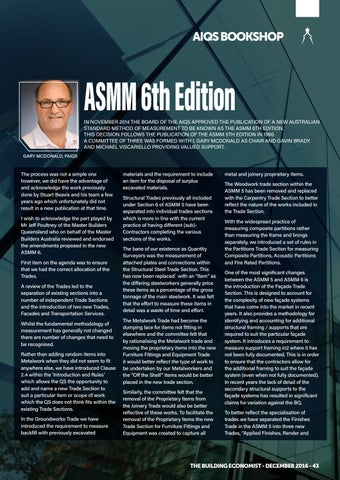AIQS BOOKSHOP
ASMM 6th Edition
IN NOVEMBER 2014 THE BOARD OF THE AIQS APPROVED THE PUBLICATION OF A NEW AUSTRALIAN STANDARD METHOD OF MEASUREMENT TO BE KNOWN AS THE ASMM 6TH EDITION. THIS DECISION FOLLOWS THE PUBLICATION OF THE ASMM 5TH EDITION IN 1990. A COMMITTEE OF THREE WAS FORMED WITH I, GARY MCDONALD AS CHAIR AND GAVIN BRADY AND MICHAEL VISCARIELLO PROVIDING VALUED SUPPORT. GARY MCDONALD, FAIQS
The process was not a simple one however, we did have the advantage of and acknowledge the work previously done by Stuart Beavis and his team a few years ago which unfortunately did not result in a new publication at that time. I wish to acknowledge the part played by Mr Jeff Poultney of the Master Builders Queensland who on behalf of the Master Builders Australia reviewed and endorsed the amendments proposed in the new ASMM 6. First item on the agenda was to ensure that we had the correct allocation of the Trades. A review of the Trades led to the separation of existing sections into a number of independent Trade Sections and the introduction of two new Trades, Facades and Transportation Services. Whilst the fundamental methodology of measurement has generally not changed there are number of changes that need to be recognised. Rather than adding random items into Metalwork when they did not seem to fit anywhere else, we have introduced Clause 2.4 within the ‘Introduction and Rules’ which allows the QS the opportunity to add and name a new Trade Section to suit a particular item or scope of work which the QS does not think fits within the existing Trade Sections. In the Groundworks Trade we have introduced the requirement to measure backfill with previously excavated
materials and the requirement to include an item for the disposal of surplus excavated materials. Structural Trades previously all included under Section 6 of ASMM 5 have been separated into individual trades sections which is more in line with the current practice of having different (sub)Contractors completing the various sections of the works. The bane of our existence as Quantity Surveyors was the measurement of attached plates and connections within the Structural Steel Trade Section. This has now been replaced` with an “Item” as the differing steelworkers generally price these items as a percentage of the gross tonnage of the main steelwork. It was felt that the effort to measure these items in detail was a waste of time and effort. The Metalwork Trade had become the dumping lace for items not fitting in elsewhere and the committee felt that by rationalising the Metalwork trade and moving the proprietary items into the new Furniture Fittings and Equipment Trade it would better reflect the type of work to be undertaken by our Metalworkers and the “Off the Shelf” Items would be better placed in the new trade section. Similarly, the committee felt that the removal of the Proprietary Items from the Joinery Trade would also be better reflective of these works. To facilitate the removal of the Proprietary Items the new Trade Section for Furniture Fittings and Equipment was created to capture all
metal and joinery proprietary items. The Woodwork trade section within the ASMM 5 has been removed and replaced with the Carpentry Trade Section to better reflect the nature of the works included in the Trade Section. With the widespread practice of measuring composite partitions rather than measuring the frame and linings separately, we introduced a set of rules in the Partitions Trade Section for measuring Composite Partitions, Acoustic Partitions and Fire Rated Partitions. One of the most significant changes between the ASMM 5 and ASMM 6 is the introduction of the Façade Trade Section. This is designed to account for the complexity of new façade systems that have come into the market in recent years. It also provides a methodology for identifying and accounting for additional structural framing / supports that are required to suit the particular façade system. It introduces a requirement to measure support framing in2 where it has not been fully documented. This is in order to ensure that the contractors allow for the additional framing to suit the façade system (even when not fully documented). In recent years the lack of detail of the secondary structural supports to the façade systems has resulted in significant claims for variation against the BQ. To better reflect the specialisation of trades we have separated the Finishes Trade in the ASMM 5 into three new Trades, “Applied Finishes, Render and
THE BUILDING ECONOMIST - DECEMBER 2016 - 43
